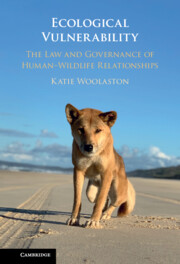Book contents
- Ecological Vulnerability
- Ecological Vulnerability
- Copyright page
- Contents
- Abbreviations
- 1 Introduction
- 2 The Human–Wildlife Relationship
- 3 Friends in the Wild?
- 4 Friends in Law?
- 5 Human–Dingo Conflict on K’gari (Fraser) Island
- 6 Human–Elephant Conflict in Northern Botswana
- 7 Pandemic Vulnerability and Resilience
- 8 Conclusion
- Index
3 - Friends in the Wild?
The Problem of Human–Wildlife Conflict and Its Governance
Published online by Cambridge University Press: 09 June 2022
- Ecological Vulnerability
- Ecological Vulnerability
- Copyright page
- Contents
- Abbreviations
- 1 Introduction
- 2 The Human–Wildlife Relationship
- 3 Friends in the Wild?
- 4 Friends in Law?
- 5 Human–Dingo Conflict on K’gari (Fraser) Island
- 6 Human–Elephant Conflict in Northern Botswana
- 7 Pandemic Vulnerability and Resilience
- 8 Conclusion
- Index
Summary
Chapter 3 is an analysis of the sociological and ecological literature surrounding the problem of human–wildlife conflict and so describes the non-legal context. It begins with an analysis of the problem itself and the terminology surrounding human–wildlife conflict. The chapter then suggests that specific management models are not equipped to deal with the value conflicts that surround instances of human–wildlife conflict. Approaches to wildlife management are heavily based on reductionist scientific formulations that exclude consideration of the needs of the community and the wildlife concerned with conflict. They often do not allow for an emotional connection with wildlife or encourage positive experiences. They also often do not consider the historical social conflicts surrounding the symptomatic wildlife behaviour. Such approaches are vulnerable to political pressure and work in conjunction with a top-down state response to exclude particular people and reduce human and ecological security. The primary finding of the chapter is that management of wildlife at the ground level most often seeks to promote individual autonomy and, as discussed in Chapter 2, such an emphasis is not conducive to an appropriate response to human–wildlife conflict.
Keywords
- Type
- Chapter
- Information
- Ecological VulnerabilityThe Law and Governance of Human–Wildlife Relationships, pp. 52 - 87Publisher: Cambridge University PressPrint publication year: 2022

